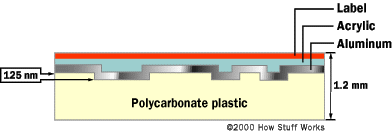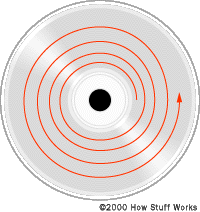
Another way of storing data is by using optics. This is the method used by compact discs to encode information. Thus, this section will focus primarily on methods used to record and retrieve data on a compact disk.
A compact disk holds 783 megabytes of information,
and puts it all on a disk 12 centimeters in diameter. This requires
that the storage of the bytes of information be packed very close together.
A typical optical disk is made of three layers: A polycarbonate base through
which light can pass, a layer of aluminum, and a protective layer of acrylic
on top of that. A cross section of a CD looks like this:
 |
Each high area of the CD is called "pit,"
and the flat section is called a "land." These pits are
are about 0.5 microns wide, and the tracks in which the pits lie are 1.6
microns apart.
 |
These tracks are arranged radially from
the center of the CD. If you could remove the track from a standard
five inch CD, it would stretch for three and a half miles. This radial
pattern has enabled some novel uses. Recently, business cards and
baseball cards have come out that actually work in a CD drive. They
are still rectangular, so after about two megabytes of data, the radial
pattern is cut off.
 |
A CD player is used it retrieve the data from the CD. While mechanically simple, a CD player is a high precision machine, since it does have to move at approximately one micron resolutions. To pass the CD under the read head, a motor spins the CD at 200 to 500 RPM, depending on which track is being read. In addition, there is a laser pickup assembly to read the laser reflections from the CD, as well as a stepper motor to move the assembly.
"The fundamental job of the CD player is to focus the laser on the track of bumps. The laser beam passes through the polycarbonate layer, reflects off the aluminum layer and hits an opto-electronic device that detects changes in light. The bumps reflect light differently than the "lands" (the rest of the aluminum layer), and the opto-electronic sensor detects that change in reflectivity. The electronics in the drive interpret the changes in reflectivity in order to read the bits that make up the bytes." (Howstuffworks.com)
While the above figure is a good representation of an audio CD player, in a computer, the data is not converted to analog (unless it is being directed to the speakers), but is kept as a digital signal for processing by the computer.
The most difficult part of a CD player's job is keeping the tracking correct. It must keep the tracking directly under the read head, make sure the pits are not moving by too fast, and move the head perpendicular to the direction of the track's motion at a rate of 1.6 microns/revolution.
Since the tracks on a CD are arranged radially, and tangential velocity (the linear velocity of a point moving in a circle) is R*(angular velocity), if the CD spins at a constants speed, the pits will be moving at faster rate near the edges of the CD than in the middle. Because of this, as the read head moves toward the edges, the motor spinning the CD slows down, maintaining a constant tangential velocity for the data track.
A short note on Re-Writable optical media
When optical media is talked about, is almost always refers to write once, read many (sometimes called WORM) media. This is due to the nature of CD's: the material used to store data can only be burned once. There also exists a standard called CD re-writable, or more commonly referred to as CD-RW.
A CD-RW disc is similar to a standard CD,
but has subtle differences to enable the storage and erasure of data.
It has the protective layer, reflective layer, and base such as a standard
CD has. Instead of standard pits, however, it uses a phase change alloy
whose reflectivity can be modified. Using a relatively high power
laser, the phase change allows the alloy to have different refractivity
indexes, creating reflective and non-reflective "pits" and "lands."
 |
Hard drives are great for mass storage at a fixed, or at least semi-fixed location. CD's are good for carrying a lot of data around, and are very durable. Problem: hard drives are not very portable. Problem: CD's are only write-once. CD-RW's take a long time to write their data. Solution: combine the two technologies, and you have magneto-optical storage.